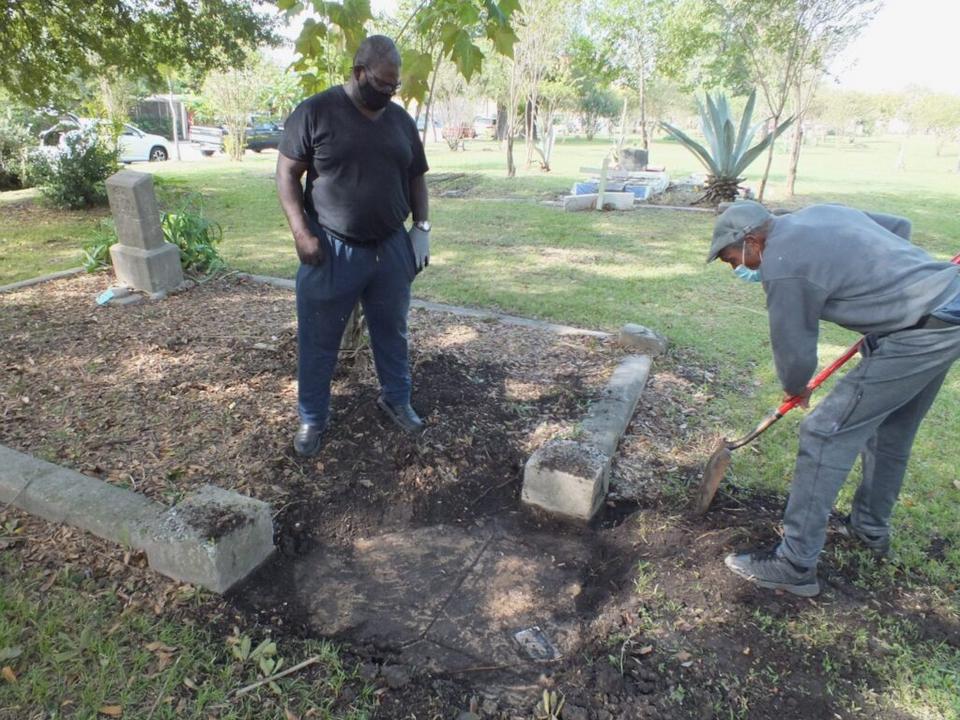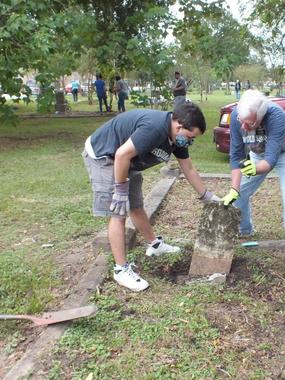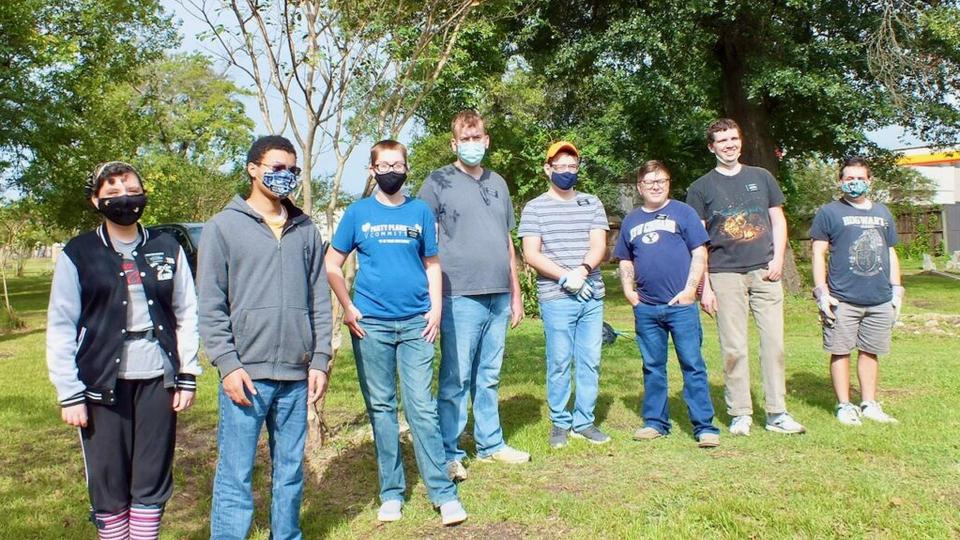- Restoring Black Cemeteries 1
- Restoring Black Cemeteries 2
- Restoring Black Cemeteries 3
- Restoring Black Cemeteries 4
- Restoring Black Cemeteries 5
- Restoring Black Cemeteries 6
- Restoring Black Cemeteries 7
- Restoring Black Cemeteries 8
| Temple Square is always beautiful in the springtime. Gardeners work to prepare the ground for General Conference. © 2012 Intellectual Reserve, Inc. All rights reserved. | 1 / 2 |
This story appears here courtesy of TheChurchNews.com. It is not for use by other media.
By Sydney Walker, Church News
Several young service missionaries for The Church of Jesus Christ of Latter-day Saints, along with their families and leaders, participated in an ongoing service project at a Houston, Texas, cemetery on Saturday, October 17.
The project is more than pruning and trimming trees, leveling sunken ground and restoring broken headstones at the Historic Evergreen Negro Cemetery. It’s about preserving lost history by identifying those buried there and building their family history.
“We’re in the process of trying to take it to the next level — the next level being to do a little bit more than just clean it up,” said Donald Williams, a caretaker for the cemetery who has coordinated with local Latter-day Saints and other organizations on this project.
“We’re actually putting a map together that will show you the locations of all the headstones that we have currently,” he said. Approximately 5,000 are buried at Evergreen — including former slaves, Buffalo soldiers and World War I veterans — but only several hundred graves have been identified so far. More are discovered every week.

Restoring Black Cemeteries 8
A map using Google Earth shows the identified graves at the Historic Evergreen Negro Cemetery in Houston, Texas. Courtesy of Donald Williams, courtesy of Church News. All rights reserved.The Historic Evergreen Negro Cemetery is one of an estimated 4,000 historic Black cemeteries throughout Texas. Many have been abandoned and neglected.
When Dr. W.W. “Woody” Jones first discovered Evergreen in the 1990s, “it was so overgrown you didn’t know a cemetery was there. It was nothing but just vines and woods.”
Jones is the founder of Project R.E.S.P.E.C.T., the trustee for Evergreen and an organization dedicated to researching, documenting, recovering, restoring and protecting abandoned cemeteries. Behind Project R.E.S.P.E.C.T., legislation was passed in Texas in 1995 to allow nonprofits to take over abandoned cemeteries.
Along with Williams, Jones is working with local Latter-day Saints and other organizations to restore the cemetery, identify graves and construct family trees. “The genealogy is important and critical to finding our ancestors,” Jones said.
“The genealogy work that the group is doing now hopefully will be spread to those other properties,” he said, referring to the other cemeteries his organization oversees. “It will tell us and give us some insight as to what we need to do to expand the scope of these properties.”

Restoring Black Cemeteries 4
Donald Williams (left) and Dr. Woody Jones (right) work on a “family plot” at the Historic Evergreen Negro Cemetery in Houston, Texas, on Saturday, October 17, 2020. Williams is a caretaker for the cemetery and Jones is the founder of Project R.E.S.P.E.C.T. which oversees the cemetery. Photo by Cristo Woodworth, courtesy of Church News. All rights reserved.For local Latter-day Saints, what started as a service opportunity for missionaries has evolved into a pilot project with FamilySearch and a community-outreach initiative now nested under the direction of an Area Seventy and stake presidents.
Using Evergreen as a model, the objective is to locate historic Black cemeteries in the Greater Houston area and work with their stewards to help identify the names of those buried and build family trees.
“We’re just getting started,” said Elder Sean Douglas, an Area Seventy, “and there’s much to happen.”
“We bring the ability to identify who’s there, and we bring helping hands to help them along the way — should they ask for it, should they want, should they desire. … We’re trying to do it hand-in-hand with the community. This is not our project. It’s a joint project, wherever we might be welcome,” Elder Douglas said.
A ‘Treasure Trove’ for Family History
Elder Albert E. Haines, a service mission leader for the Houston Texas South Area, first met with Williams and Jones several months ago to learn about their efforts and discuss ways that Latter-day Saints might be able to help.
“This is all about serving this marvelous community and supporting them and their efforts to identify and appreciate a heritage and a history that has been largely ignored,” Elder Haines said.

Restoring Black Cemeteries 6
Elder Baker, (left) a Church service missionary, and Elder Albert E. Haines, (right) service mission leader, discover a buried headstone at the Historic Evergreen Negro Cemetery in Houston, Texas, on Saturday, October 17, 2020. Photo by Cristo Woodworth, courtesy of Church News. All rights reserved.Following the Emancipation Proclamation and 13th Amendment to the U.S. Constitution in 1865, a large number of freed slaves migrated to rural areas of southeast Texas, he explained. Many worked as indentured servants for plantation owners.
For about the next 100 years, Jim Crow laws marginalized African Americans in nearly every aspect of life. Segregation was enforced in education, home ownership, public parks, theaters, restaurants, restrooms — and even cemeteries.
As these Black cemeteries have been neglected over the years, “a huge segment of our history hasn’t been written, let alone told,” Elder Haines said. These cemeteries contain “a treasure trove for African American family history research.”
FamilySearch and Brigham Young University (BYU) Involvement
Working with community leaders, FamilySearch is conducting a pilot project to help identify those who are buried in various Black cemeteries throughout a seven-county area (Harris County, Brazoria County, Fort Bend County, Montgomery County, Washington County, Galveston County and Walker County).
“One of the first things we’re doing is working with Brigham Young University’s Record Linking Lab,” said Brent Hansen, FamilySearch program manager for African Heritage.
The Record Linking Lab, overseen by Dr. Joseph Price, is using automated tools to pull information — such as the cemetery and undertaker — from Texas death records previously digitized and indexed by FamilySearch.
“Although FamilySearch would have indexed the name of the person and the date of death, they didn’t index all fields in those death records,” Hansen said.
The lab’s process involves skewing (making the record image straight), segmenting (teaching the machine the location of the desired fields) and using handwriting recognition to read the information, said Price.
“In some of these cemeteries, you can’t read the tombstones or the gravestones, but the death records let us know where people should be,” Price said. “And so even if we can’t read the gravestone, we might be able to know, or at least tell people, in which cemetery their ancestors are buried.”
Once a list of names is populated for a specific cemetery, “FamilySearch will work with the community if they choose to add those names into the family tree,” Hansen said.
He continued, “Once they get the family tree, it can be a connected experience with other records that exist, and for the families to search and find. We’ll also be sharing that information back with each of those people that have responsibility for the cemetery.”
Mobilizing Houston Stakes
John Allen and his wife, Denise Allen, of the Westlake Ward, Houston Texas Bear Creek Stake, were recently called to be coordinators of this community outreach initiative, currently referred to as the Black Heritage Initiative.
Working with the 22 stakes in Greater Houston, their role is to identify Black cemeteries in the area and work with trustees who oversee them. They will then help stake leaders adopt a cemetery and mobilize resources within their stake and community to beautify the site and build family trees.

Restoring Black Cemeteries 7
(From left) Sister Cristo Woodworth and Elders Fears, Williams, Boehner, Mena, Carroll, Nicholas and Baker pose for a photo after volunteering at the Historic Evergreen Negro Cemetery in Houston, Texas, on Saturday, October 17, 2020. Photo by Cristo Woodworth, courtesy of Church News. All rights reserved.“The next step after that would be to teach members of the African American community whose ancestors are buried there how to do their own family history and build their own family trees,” John Allen said.
He agreed with Elders Douglas and Haines that this initiative is all about “pure service, helping people connect to their ancestry and building bridges of understanding, appreciation, recognition and mutual respect.”
Copyright 2020 Deseret News Publishing Company